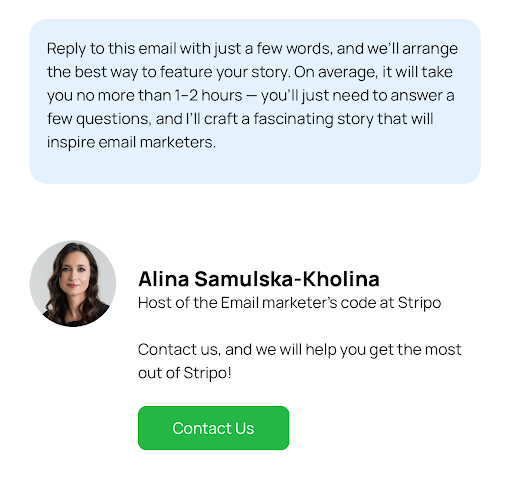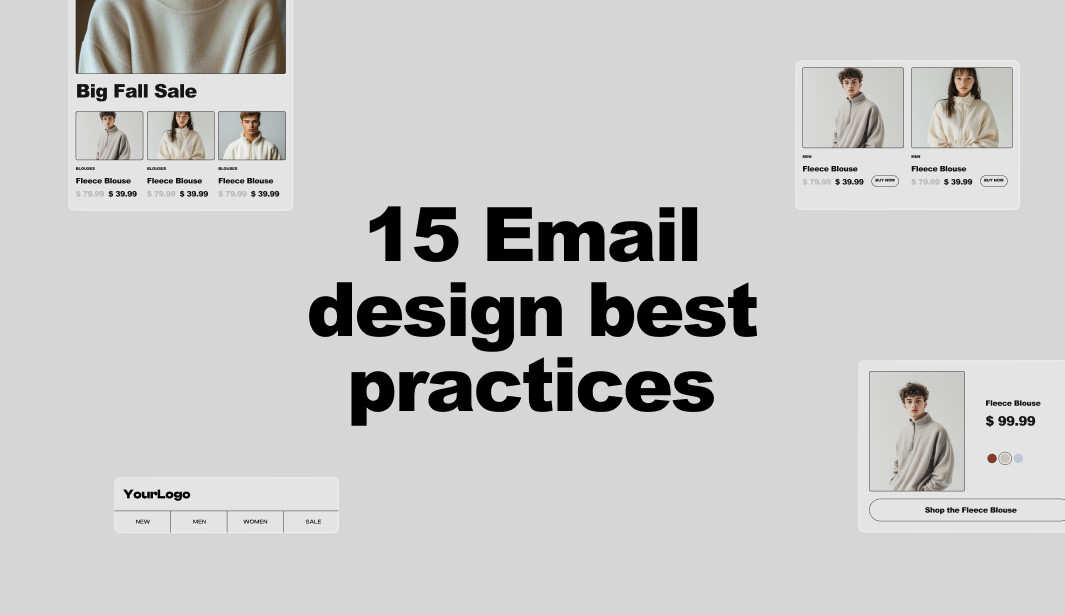In email marketing, we constantly talk about personalization. It’s everywhere: in subject lines, content, and calls to action. But here’s something that caught my attention—why do we rarely discuss sender personalization?
An email isn’t just us writing to a recipient. It’s a conversation between two people—the reader and the sender—yet most strategies focus solely on the former. Therefore, I’ve compiled this article (not as an academic study or tutorial) as a collection of observations, expert opinions, case studies, and personal insights from conversations with email marketers and market analysis. My goal was to understand the following: when does a signature such as “David, marketer” actually work? When does it lead to unsubscribes? When is a brand name more appropriate than a personal sender? Finally, how are brand perception, engagement metrics, and trust impacted?
To gain a deeper perspective on what truly matters from the recipient’s perspective, I consulted with Galina Panasyuk, a long-time expert in the field. Her experience spans multiple industries, from eCommerce to service-based businesses. She has worked with diverse audiences across various countries, handling millions of subscribers. Her insights are invaluable for this discussion.
Industry-specific trends and expert insights: When personalization works—and when it backfires
According to Jay Schwedelson, emails sent from a specific individual rather than a brand can achieve higher open rates of up to 4.5 times in B2B and 2.75 times in B2C. In other words, recipients are more likely to open an email when they recognize a familiar or at least human-sounding sender. This creates a sense of dialogue rather than an impersonal mass blast—especially valuable in B2B, where direct communication and trust are key.
However, the effect isn’t always straightforward. Name recognition plays a critical role. If the email comes from an unfamiliar person, it can trigger anxiety rather than trust.
The effectiveness of personalized sender names in email marketing depends heavily on industry specifics. Open rates must be considered in the context of who the email is being sent to and why. Average open rates vary significantly across industries, and depending on the sector, senders’ names may hold varying levels of influence.
SaaS and B2B: The power of human connection
In B2B, the human factor is crucial, especially within Software as a Service (SaaS) where the audience consists of professional users. These relationships rely on trust, expertise, and a sense of direct communication. The average open rate in this category is around 22–23%, though recent aggregator data suggests it can reach 35% if the sender is a well-known figure within the company, such as the CEO, Head of Product, or a key expert.
Using a real name and title isn’t simply about increasing open rates—it also affects engagement. In non-commercial B2B sectors, this is particularly evident: emails from department heads or recognized experts achieve higher open rates because recipients recognize and trust the sender, sometimes even having direct contact with them.
One example from our experience: at Stripo, we run a Product Pulse digest featuring product updates, typically sent by our email marketer in a standard newsletter format. However, as the content was prepared by our COO, Dmytro, we decided to align the sender’s name to reflect this.
Surprisingly, the open rate didn’t change as dramatically as I had expected; what did change was engagement. At the end of the email, we included a quick survey asking, “Was this email informative to you?” and “Would you like to receive similar updates?” Once we switched the sender to the COO, recipients became significantly more responsive—completing the survey, leaving comments, and even replying directly. This reinforced the perception of trust and importance.
 |
 |
eCommerce and B2C: When brand recognition matters more than a personal name
In online retail and other B2C sectors, the sender’s name also plays a role, albeit in a different way. Open rates in this space are historically lower—around 17–20% on average—which makes sense given the volume of promotional emails that subscribers receive daily. Competition for attention is fierce, and the first thing a recipient notices is brand recognition, not the name of a specific employee.
This explains why emails from a verified brand name often inspire more trust than those from “Bob, the marketer”—especially if the recipient has never interacted with Bob before. In fact, if an email lands in an expected promotional time slot but is signed by an unfamiliar name, it might lead to confusion or even irritation, disrupting the familiar pattern: the recipient expects promos from known brands but instead receives “personal” material, leading to cognitive dissonance.
However, this doesn’t mean that personalized signatures are always inappropriate in eCommerce. On the contrary, they can be effective if they are thoughtfully and deliberately integrated into the strategy. Some large brands use hybrid schemes where the employee’s name is combined with the brand name, for example, “Oleksandr from Comfy.” This gives the feeling of live communication while not detaching the email from a familiar brand. This approach is particularly relevant in triggered emails, where support or engagement is more important than simply promoting an offer.
The key here is to define areas of responsibility: where it is appropriate to use a person’s name or the brand name? For example:
- promotional emails, special offers, and seasonal discounts sent directly from the brand appear to be more logical, as these communications are aimed at maximum clicks, and a personal name would only get in the way.
This trend was confirmed by a study from GoDaddy, where about 60% of consumers said that they trusted emails sent directly from a brand than those sent by an employee or company owner. A brand name in the “From” field provides a clear understanding of the sender and reduces the likelihood of confusion, doubt, or anxiety regarding spam. For this reason, many eCommerce and travel brands have a preference for corporate communication—especially if the sender isn’t a widely recognized figure to most of their customers.
of consumers trust emails sent from a brand’s name more than those sent by an employee.
Another important point here is sender verification. If a brand uses its name in the “From” field, it’s also necessary to activate sender authentication (e.g., BIMI in Gmail or other email clients). This boosts trust and shows that the sender is verified and legitimate, not a fake account or spammer. In an era characterized by increased phishing and email fraud, this plays a crucial role.
- welcome email sequences, product usage tips, and feedback collection emails are all materials in which a specific employee’s name can be used, provided it fits into the strategy and is accompanied by context.
It all boils down to the KPIs that marketers set in the planning stage. If the goal of the campaign is fast clicks and mass reach, the brand name works best. If the goal is to build trust, initiate engagement, and drive involvement, then personal names should be added.
But—this is critically important—you can’t just use a personal name “for the sake of it.”
If you decide to add a name to the email, explain who this person is and why they are writing. Set the right tone of voice, create context, and show that there’s a real person behind the email who’s interested in engaging in dialogue. Only then will such an email be perceived as appropriate and sincere. Otherwise, it will appear to be a forced trick—and the recipient will reject it.
Thus, in B2C, it’s important to develop a signature strategy from the very beginning. Separate roles, understand where the brand, person, or hybrid mix should be, and make each email part of a cohesive communication system, not just a one-off attempt to add “warmth” to the template.
Tourism and the travel industry: Personalization based on perception
Email marketing in the tourism industry is of fundamental importance. It’s one of the few B2C segments where the email subject triggers an immediate emotional response. Travel inspires, and vacation dreams captivate. This is exactly what allows for more personalization than in classic retail.
According to research, the average open rate in the travel industry is around 20%, slightly higher than in other B2C sectors. The reason is simple: emails about trips, tours, and vacations evoke an emotional reaction, especially when they are well designed visually and linguistically.
In this industry, a personalized signature can truly work powerfully but only in the right context. If an email is sent on behalf of a personal travel agent or consultant offering to choose an itinerary, remind clients about travel details, or inform them of a discount, it is perceived as caring. This is especially true for high-end travel, where every detail and personal approach—tailored to names, interests, and past travel history—matters.
In the premium segment, an email can be more than just communication—it can be an accompaniment: an email from “your travel manager” with a name, a real email address, and a clear purpose, resulting in high engagement.
However, all of this works only if the processes are perfectly aligned. Once something breaks in the chain—wrong route, wrong hotel, wrong date—personalization becomes a vulnerability. When a user expects precision from their manager, they feel doubly upset. In such cases, a brand signature is a safe and stable choice, especially if the company is large and has a wide reach and flow of offers. For these brands, it’s important to maintain consistency and not create false expectations of personal contact in its absence.
Here, context is the decisive factor. As Galina pointed out, it’s not so much the signature that matters but the overall communication. The way in which the recipient is addressed, the content of the email, its purpose, and the level of engagement all determine which type of signature will be appropriate. In the travel industry, there is a wide variety of emails:
- discount and promotional hotel emails;
- flight offer selections based on destination;
- information about route changes;
- personalized offers based on travel history;
- support before, during, and after travel, etc.
Each category requires its own tone and sender.
The signature as a strategic element in emails
Recently, our team faced a task: gathering a pool of users to participate in a new blog section dedicated to case studies involving email marketers. We weren’t just looking for numbers—we wanted real stories. To access such cases, we needed to reach out to people personally, so we decided to send an email on behalf of Alina, the author of this section and the blog’s content editor.
The email was simple and direct: an introduction to the new section, an invitation to share experiences, a link to the questionnaire, and a proposal to contribute to content creation. No discounts or flashy headlines—just a real email from a real person with a clear request. It worked. We began receiving completed questionnaires and responses. The recipients engaged because they perceived a personal invitation—not from a brand or faceless “editorial team” but from a specific person with a real task.


Another crucial point is how frequently you change the signature. If you switch senders too often, it raises suspicion, with subscribers beginning to feel like they’re dealing with a staged act rather than real people. This is especially problematic if the emails remain identical, where only the sender’s name changes. It doesn’t build trust—quite the opposite. Loyalty is built through consistency, just like in real relationships.
Therefore, if you introduce a new sender, consider who they are, what role they play, and what types of emails would logically come from them. Plan the scenario:
- How often do they appear?
- How do they write?
- How do they respond to feedback?
Without this, a signature is just a visual trick, and when there’s nothing behind it, trust crumbles. This leads to another important factor: the overall impact of email signatures on brand perception.
Brand perception: The signature as a factor of trust and image
A signature in an email is not just a way to enhance personalization. It is part of the brand’s communication code, directly influencing trust, loyalty, and, ultimately, the company’s image. How a brand speaks to its subscribers in emails, whose voice it uses, and how consistent this messaging is all determine whether people perceive the brand as genuine and honest or an abstract marketing machine.
Humanizing the brand: When it works
When an email is signed by a real person—especially someone who is genuinely involved in what it discusses—the brand feels closer to the recipient. However, this does not mean that the entire email communication should be turned into a performance comprising fake characters.
For example, an email from the company’s CEO is appropriate when:
- communicating with investors or partners;
- sharing strategic changes;
- inviting recipients to exclusive events;
- announcing important corporate updates.
However, a CEO’s signature in an email with the subject line “Your order has been placed!” would likely elicit distrust and an ironic smile. The recipient would feel that they are being deceived, thereby undermining trust. The same applies to signatures from “CTOs,” “community managers,” or “growth team experts” if these individuals are not publicly recognized or visible. A signature should be authentic and justified.
Don’t create characters—build a system
As Galina rightly noted, there is no need to create dozens of fictional personas. The key is not the number of names but ensuring that each one is linked to a specific area of responsibility. This approach is likely to help avoid confusion or the perception of artificiality among recipients. Instead, they will become familiar with the communication style of each sender.
For example:
- Alina, the author of the email marketing case study section, genuinely collects these stories and communicates with marketers;
- Olha, the head of content, can send emails to blog subscribers (which I occasionally do myself)—and it will feel organic;
- Dmytro, the company’s COO, shares product updates because he is directly involved in these processes;
- Oleksandr, the email marketer managing email sequences, signs off on behavioral and triggered emails because he is responsible for the strategy.
In all other cases, a branded signature is more appropriate, especially for promotional emails or technical notifications. “Maria, the Busfor Team” or “Artem, the Blog Editorial Team” can also work if the person represents a specific project but their name is not widely known to the audience.
Consistency = Trust
Recipients become accustomed to the “voice” of an email. They recognize who sends what type of information. This builds expectations—the foundation of trust. Once you start mixing styles and signatures and introducing a multitude of names within a short space of time, it creates chaos and artificiality and weakens connection.
Communication built on real projects and clearly defined responsibilities of real people always works. It doesn’t require tricks because it is based on truth.
A signature is not just a line at the bottom of an email. It is the brand’s representative at a specific point in the subscriber journey. Therefore, if it behaves in a human way, knows what it’s talking about, remains consistent, and doesn’t feel forced, the brand itself will be perceived in the same way.
Moreover, in terms of brand perception in general, it’s worth noting that if email marketing genuinely aims for personalization, it should consider not just subscriber behavior but also cultural factors. A recipient’s country, business etiquette, national characteristics, and even the timing of the email all affect how an email is perceived and, consequently, its effectiveness. This is particularly true when it comes to the “From” field.
Regional specifics: How culture and mentality influence sender perception
For example, American audiences are accustomed to informal communication. In the Middle East, interactions are more traditional and formal. Addressing someone by name without a title is taboo. A signature such as “Maria from the Support Team” might be seen as disrespectful, especially when addressing an important client.
The French value formality. Even in a personal email, using titles such as “Monsieur” or “Madame” before the recipient’s last name is essential. A signature such as “Antoine from the Support Team” is acceptable, but the email itself must maintain a reserved, professional tone. Respect for language and etiquette is key to successful communication.
Meanwhile, in China and Japan, hierarchy and status form the foundation of communication. A sender’s name must always be accompanied by a title, and using one’s first name is only acceptable after establishing a trusting relationship. Without this, the email may come across as impolite. In many cases, even internal company emails start with a title and surname.
International email marketing requires micro-strategies tailored to each region. An email that works perfectly in New York might be perceived as disrespectful in Dubai or too impersonal in Paris. This is not just a matter of preference—it has a direct impact on effectiveness.
Cultural context determines:
- which sender is perceived as trustworthy;
- which forms of address are acceptable;
- what level of personalization is appropriate;
- when an email is more likely to be opened eagerly;
- whether an informal tone and humor are suitable;
- how the sender’s gender and position are perceived.
Ideally, when designing an email communication strategy, separate scenarios should be created for key cultural clusters. This isn’t just a trend—it’s a proven way to build trust and increase engagement.
One of the most important factors in any strategy are measurable results.
Conversions: The signature as a trust and action trigger
The primary metrics used in email marketing are the open rate (OR) and click-through rate (CTR). However, even the highest OR and CTR won’t yield results without follow-up. Thus, we must always analyze whether the clickable, “alive” sender actually led to the target action.
In most industries, conversion rates typically range between one and five percent, depending on the segment:
- in eCommerce, conversion rates may be around 1–2%;
- in SaaS and B2B, particularly with highly targeted segmentation, conversion rates tend to be higher, though the volume of recipients is lower.
A well-crafted sender signature helps widen the top of the funnel by increasing open rates and click-throughs. From there, the email content and offer take over. Therefore, optimizing the sender signature isn’t a replacement for a strong product—it’s a catalyst for improving the entire conversion chain.
If there’s any doubt, testing is a must. A/B testing of sender signatures is a powerful tool, especially when done strategically:
- brand vs. individual: Does an email from a company perform better than one from a named person?
- different roles: Compare an email from an email marketer vs. an email from the CEO;
- different tones: One version is more formal, the other more conversational.
Important note: Avoid A/B testing on broad campaigns such as newsletters or welcome emails—statistical differences will likely be insignificant. Focus on high-impact emails, such as abandoned cart emails, contract or agreement emails, and demo invitations. These scenarios can reveal real differences in recipient perception and response.
An email from the company will occasionally perform better than one from an individual, especially if:
- the content is technical, straightforward, or purely informational;
- the recipient is accustomed to a stable, brand-consistent tone;
- a personal signature might feel out of place or create a disconnect.
In such cases, forcing personalization for the sake of it would be illogical. It would be better to send the email from the brand and maintain a consistent perception.
Wrapping up
Personalized signatures in email campaigns can significantly impact performance—but only when integrated into a thoughtful strategy. Simply adding a name and photo isn’t enough. The approach must be logical, structured, and aligned with the overall email communication plan.
Key takeaways:
- Start with strategy, not creativity. Personalization should be embedded into your email marketing framework. Instead of randomly testing sender names, ask,
“Where in the recipient journey does a personal sender make sense, and where should it be the brand?” - Create a sender map. Define which emails come from whom: When should the brand be the sender? When should an individual represent the company? When does a hybrid approach make sense (e.g., Hanna from [Company Name])?
- Use A/B testing wisely. Don’t just measure the open rate—analyze the quality of interactions. Sometimes, a CEO’s signature won’t increase open rates but will improve engagement and response quality. Focus on meaning, not just numbers.
- Be mindful of cultural differences. What works in one region may not work in another. For example, gender pronouns (he/she/they) are common in the United States but may be inappropriate in Arab countries. Always consider local context before scaling a template.
- Content is primary; the signature is a supporting factor. A sender signature won’t save a weak email copy. It won’t sell a poor offer. But it will enhance a strong message, adding credibility and a human touch. The signature is a finishing touch, not the foundation.
- Don’t overload recipients with characters. Too many senders can confuse recipients and erode trust. Keep a clear, structured system: “One person stands behind this project and is accountable for it.”
- Consistency builds trust. If an email comes from the head of product, follow-ups on the same topic should also come from them. If recipients reply, ensure that their response goes to a real inbox—otherwise, you lose the feeling of real communication you’ve worked so hard to build.
The sender’s signature bridges the brand and the recipient. If done intentionally, it strengthens the connection. If done randomly, it risks weakening it.










0 comments